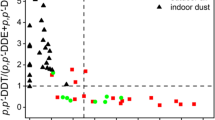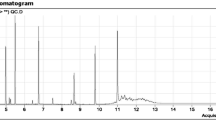Abstract
Today, many raw materials used in factories may have a dangerous effect on the physiological system of workers. One of them which is widely used in the polyurethane factories is diisocyanates. These compounds are widely used in surface coatings, polyurethane foams, adhesives, resins, elastomers, binders, and sealants. Exposure to diisocyanates causes irritation to the skin, mucous membranes, eyes, and respiratory tract. Hexamethylene diamine (HDA) is metabolite of hexamethylene diisocyanate (HDI). It is an excretory material by worker’s urine who is exposed to HDI. Around 100 air samples were collected from five defined factories by midget impinger which contained dimethyl sulfoxide absorbent as a solvent and tryptamine as reagent. Samples were analyzed by high-performance liquid chromatography with EC\UV detector using NIOSH 5522 method of sampling. Also, 50 urine samples collected from workers were also analyzed using William’s biological analysis method. The concentration of HDI into all air samples were more than 88 xxxμg/m3, and they have shown high concentration of pollutant in the workplaces in comparison with NIOSH standard, and all of the workers’ urine were contaminated by HDA. The correlation and regression test were used to obtain statistical model for HDI and HDA, which is useful for the prediction of diisocyanates pollution situation in the polyurethane factories.
Similar content being viewed by others
References
Allport, D. C., Gilbert, D. S., & Outterside, S. M. (2003). MDI and TDI: Safety, health and the environment. A source book and practical guide. Hoboken, NJ, USA: Wiley.
Alshibli, K. A., Sture, S. (1999). Sand shear band thickness measurements by digital imaging techniques. Journal of Computing in Civil Engineering, 13(2), 103–108.
Bello, D., Streicher, R. P., & Woskie, S. R. (2002). Evaluation of the NIOSH draft method 5525 for determination of the total reactive isocyanate group (Trig) for aliphatic isocyanates in auto body repair shops. Journal of Environmental Medicine, 4, 351–360.
HSE. Health and Safety Executive (1999). Methods for the determination of hazardous substances; MDHS 25/3. Organic isocyanates in air. Sudbury UK: Health and Safety Laboratory.
Jaecker-Voirol, A., & Pelt, P. (2000). PM10 emission inventory in Ile de France for transport and industrial sources: PM10 re-suspension, a key factor for air quality. Environmental Modelling & Software, 15(6–7), 575–581.
Key-Schwartz, R. J. (1994). Evaluation of recoveries of several prepolymeric isocyanate products using NIOSH methods 5521 and 5522 (unpublished data). Cincinnati, OH: US Dept. of Health and Human Services, Public Health Service, Centers for Disease Control and Prevention, National Institute for Occupational Safety and Health.
Maitre, A., Berode, M., Perdrix, A., Romazini, S., & Savolainen, H. (1993). Biological monitoring of occupational exposure to toluene diisocyanate. International Archives of Occupational and Environmental Health, 65, 97–100.
NIOSH (1994). Determination of airborne isocyanate exposure. NIOSH manual of analytical methods (Chapter K, 4th ed). Cincinnati, OH: US Department of Health and Human Services, Public Health Service, Centers for Disease Control and Prevention, National institute for occupational safety and health, DHHS (NIOSH) publication no. 94-113.
Roemmelt, H., & Fruhmann, G. (1994). Respiratory and other hazards of isocyanates. International Archives of Occupational and Environmental Health, 66, 141–152. doi:10.1007/BF00380772.
Sparer, J., Stowe, M., Bello, D., et al. (2004). Isocyanate exposures in auto body shop work: The SPRAY study. Journal of Occupational and Environmental Hygiene, 1, 570–581.
Tury, B., Pemberton, D., & Bailey, R. E. (2003). Fate and potential environmental effects of methylenediphenyl diisocyanate and toluene diisocyanate released into the atmosphere. Journal of the Air & Waste Management Association, 53(1), 61–66.
Tinnerberg, H., & Sennbro, C. J. (2005). Assessment of exposure to aromatic diisocyanates air or biological monitoring. In IOHA 2005 Pilanesberg, Paper G1-4.
Vandenplas, O., Cartier, A., Lesage, J., Perrault, G., Grammar, L. C., & Malo, J. L. (1992). Occupational asthma caused by a prepolymer but not the monomer of toluene diisocyanate (TDI). The Journal of Allergy and Clinical Immunology, 89, 1183–1188. doi:10.1016/0091-6749(92)90303-J.
Williams, N. R., Jones, K., & Cocker, J. (1999). Biological monitoring to assess exposures from use of isocyanates in motor vehicle repair. Occupational & Environmental Medicine, 56, 598–601.
Woskie, S. R., Sparer, J., Gore, R. J., Stowe, M., Bello, D., Liu, Y., et al. (2004). Determinants of isocyanate exposures in auto body repair and refinishing shops. Annals of Occupational Hygiene, 48(5), 393–403.
Wu, W. S., Stoyanoff, R. E., Szklar, R. S., & Gaind, V. S. (1990). Application of tryptamine as a derivatizing agent for airborne isocyanate determination: Part 3. Evaluation of total isocyanates analysis by high performance liquid chromatography with fluorescence and amperometric detection. Analyst, 115, 801–807.
Author information
Authors and Affiliations
Corresponding author
Rights and permissions
About this article
Cite this article
Mirmohammadi, M., Hakimi Ibrahim, M., Ahmad, A. et al. Indoor air pollution evaluation with emphasize on HDI and biological assessment of HDA in the polyurethane factories. Environ Monit Assess 165, 341–347 (2010). https://doi.org/10.1007/s10661-009-0950-5
Received:
Accepted:
Published:
Issue Date:
DOI: https://doi.org/10.1007/s10661-009-0950-5




